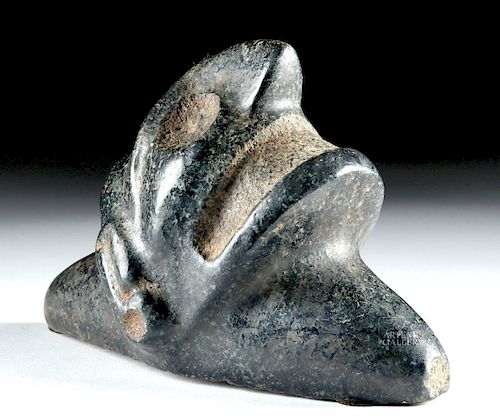Taino Stone Zemi Figure w/ Stoetzer Report
Lot 200a
About Seller
Artemis Gallery
686 S Taylor Ave, Ste 106
Louisville, CO 80027
United States
Selling antiquities, ancient and ethnographic art online since 1993, Artemis Gallery specializes in Classical Antiquities (Egyptian, Greek, Roman, Near Eastern), Asian, Pre-Columbian, African / Tribal / Oceanographic art. Our extensive inventory includes pottery, stone, metal, wood, glass and textil...Read more
Estimate:
$2,200 - $3,300
Absentee vs Live bid
Two ways to bid:
- Leave a max absentee bid and the platform will bid on your behalf up to your maximum bid during the live auction.
- Bid live during the auction and your bids will be submitted real-time to the auctioneer.
Bid Increments
| Price | Bid Increment |
|---|---|
| $0 | $25 |
| $300 | $50 |
| $1,000 | $100 |
| $2,000 | $250 |
| $5,000 | $500 |
| $10,000 | $1,000 |
| $20,000 | $2,500 |
| $50,000 | $5,000 |
| $100,000 | $10,000 |
| $200,000 | $20,000 |
About Auction
By Artemis Gallery
Jun 20, 2019
Set Reminder
2019-06-20 10:00:00
2019-06-20 10:00:00
America/New_York
Bidsquare
Bidsquare : Ancient / Ethnographic From Around the World
https://www.bidsquare.com/auctions/artemis-gallery/ancient-ethnographic-from-around-the-world-4217
Around the world & back in time - be amazed at the treasures you will find. Antiquities from Egypt, Greece, Italy and the Near East, Asian, Pre-Columbian, African / Tribal / Oceanic, Native American, Spanish Colonial, Russian Icons, Fine Art, much more! All categories, all price ranges.. all legal Artemis Gallery info@artemisgallery.com
Around the world & back in time - be amazed at the treasures you will find. Antiquities from Egypt, Greece, Italy and the Near East, Asian, Pre-Columbian, African / Tribal / Oceanic, Native American, Spanish Colonial, Russian Icons, Fine Art, much more! All categories, all price ranges.. all legal Artemis Gallery info@artemisgallery.com
- Lot Description
Pre-Columbian, Caribbean, Taino, ca. 1100 to 1558 CE. Among the only artifacts specifically referenced by Spanish chroniclers of the 15th century, a quintessential example of a three pointer stone Zemi figure - a human effigy face carved from a single piece of mottled black stone with meticulously pecked and incised skeletal features including a pair of deep-socketed round eyes, a wide open mouth, and a prominent protruding nose, as well as a decorative headband, adding to the impressive aesthetic and spiritual presence of this piece. The This piece is among the various cult objects associated with the worship of "zemis" - deities, ancestors, or earth spirits revered by the Taino culture. Size: 7.375" L x 4.875" H (18.7 cm x 12.4 cm)
The Zemi (or Cemi) stone, with its characteristic three cardinal points, is a fundamental symbol in the Taino religion. Tainos traditionally name the three points "Yocahu Bagua Maorocoti" - another word for the Creator, Yaya. Zemis like this example are believed to be inhabited by powerful spirits. The uppermost point represents the top of this sacred mountain peak, in the turey (sky) of the four directions, where Yaya - the Creator, whose name means that which has neither beginning nor end and which has no male ancestor or creator - resides. The 'chin' point represents Coabey, the underworld or place of the dead. Here Hupia, the spirit of the dead, resides, and the face of Guayaba, the Chief of Coabey, is represented. Finally, the opposite point represents the land of the living where Goiz, the spirit of living people, resides. A similar three-pointer example is shown in fig. 29a, p. 117 in "The Tainos: Rise and Decline of the People Who Greeted Columbus", (Irving Rouse, 1992).
A copy of Stoetzer examination report #092518.1 is available for this piece. This document is quite extensive and concludes, "We note many features on the surface of this item overall including signs of production, specific tooling signatures and degradation of the surface of the stone which are consistent with antiquity and the effects of subsequent natural weathering conditions. It is important to note that we find no signs we interpret as being a product of any modern manufacturing, tooling, working of the material or indications of artificial weathering overall." (November 2, 2018)
Provenance: private Los Angeles County, California, USA collection, acquired in the Dominican Republic over 20 years ago; a copy of an authenticating examination report #092518.1 (November 2, 2018) from Stoetzer, Inc. Fine Art Services, Miami, Florida, USA is available for this piece
All items legal to buy/sell under U.S. Statute covering cultural patrimony Code 2600, CHAPTER 14, and are guaranteed to be as described or your money back.
A Certificate of Authenticity will accompany all winning bids.
We ship worldwide and handle all shipping in-house for your convenience.
#127596Normal surface weathering, chips to peripheries, minute nicks here and there, and earthen deposits. All is commensurate with age and the piece is generally excellent.Condition
- Shipping Info
-
All shipping is handled in-house for your convenience. Your invoice from Artemis Gallery will include shipping calculation instructions. If in doubt, please inquire BEFORE bidding for estimated shipping costs for individual items.
-
- Buyer's Premium



 EUR
EUR CAD
CAD AUD
AUD GBP
GBP MXN
MXN HKD
HKD CNY
CNY MYR
MYR SEK
SEK SGD
SGD CHF
CHF THB
THB
















